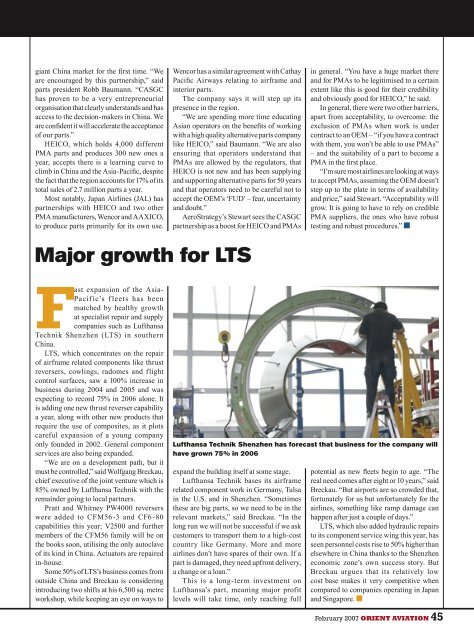Japan Airlines - Orient Aviation
Japan Airlines - Orient Aviation
Japan Airlines - Orient Aviation
- No tags were found...
Create successful ePaper yourself
Turn your PDF publications into a flip-book with our unique Google optimized e-Paper software.
giant China market for the first time. “Weare encouraged by this partnership,” saidparts president Robb Baumann. “CASGChas proven to be a very entrepreneurialorganisation that clearly understands and hasaccess to the decision-makers in China. Weare confident it will accelerate the acceptanceof our parts.”HEICO, which holds 4,000 differentPMA parts and produces 300 new ones ayear, accepts there is a learning curve toclimb in China and the Asia-Pacific, despitethe fact that the region accounts for 17% of itstotal sales of 2.7 million parts a year.Most notably, <strong>Japan</strong> <strong>Airlines</strong> (JAL) haspartnerships with HEICO and two otherPMA manufacturers, Wencor and AAXICO,to produce parts primarily for its own use.Wencor has a similar agreement with CathayPacific Airways relating to airframe andinterior parts.The company says it will step up itspresence in the region.“We are spending more time educatingAsian operators on the benefits of workingwith a high quality alternative parts companylike HEICO,” said Baumann. “We are alsoensuring that operators understand thatPMAs are allowed by the regulators, thatHEICO is not new and has been supplyingand supporting alternative parts for 50 yearsand that operators need to be careful not toaccept the OEM’s ‘FUD’ – fear, uncertaintyand doubt.”AeroStrategy’s Stewart sees the CASGCpartnership as a boost for HEICO and PMAsin general. “You have a huge market thereand for PMAs to be legitimised to a certainextent like this is good for their credibilityand obviously good for HEICO,” he said.In general, there were two other barriers,apart from acceptability, to overcome: theexclusion of PMAs when work is undercontract to an OEM – “if you have a contractwith them, you won’t be able to use PMAs”– and the suitability of a part to become aPMA in the first place.“I’m sure most airlines are looking at waysto accept PMAs, assuming the OEM doesn’tstep up to the plate in terms of availabilityand price,” said Stewart. “Acceptability willgrow. It is going to have to rely on crediblePMA suppliers, the ones who have robusttesting and robust procedures.”Major growth for LTSFast expansion of the Asia-Pacific’s f leets has beenmatched by healthy growthat specialist repair and supplycompanies such as LufthansaTechnik Shenzhen (LTS) in southernChina.LTS, which concentrates on the repairof airframe related components like thrustreversers, cowlings, radomes and flightcontrol surfaces, saw a 100% increase inbusiness during 2004 and 2005 and wasexpecting to record 75% in 2006 alone. Itis adding one new thrust reverser capabilitya year, along with other new products thatrequire the use of composites, as it plotscareful expansion of a young companyonly founded in 2002. General componentservices are also being expanded.“We are on a development path, but itmust be controlled,” said Wolfgang Breckau,chief executive of the joint venture which is85% owned by Lufthansa Technik with theremainder going to local partners.Pratt and Whitney PW4000 reverserswere added to CFM56-3 and CF6-80capabilities this year; V2500 and furthermembers of the CFM56 family will be onthe books soon, utilising the only autoclaveof its kind in China. Actuators are repairedin-house.Some 50% of LTS’s business comes fromoutside China and Breckau is consideringintroducing two shifts at his 6,500 sq. metreworkshop, while keeping an eye on ways toLufthansa Technik Shenzhen has forecast that business for the company willhave grown 75% in 2006expand the building itself at some stage.Lufthansa Technik bases its airframerelated component work in Germany, Tulsain the U.S. and in Shenzhen. “Sometimesthese are big parts, so we need to be in therelevant markets,” said Breckau. “In thelong run we will not be successful if we askcustomers to transport them to a high-costcountry like Germany. More and moreairlines don’t have spares of their own. If apart is damaged, they need upfront delivery,a change or a loan.”This is a long-term investment onLufthansa’s part, meaning major profitlevels will take time, only reaching fullpotential as new fleets begin to age. “Thereal need comes after eight or 10 years,” saidBreckau. “But airports are so crowded that,fortunately for us but unfortunately for theairlines, something like ramp damage canhappen after just a couple of days.”LTS, which also added hydraulic repairsto its component service wing this year, hasseen personnel costs rise to 50% higher thanelsewhere in China thanks to the Shenzheneconomic zone’s own success story. ButBreckau argues that its relatively lowcost base makes it very competitive whencompared to companies operating in <strong>Japan</strong>and Singapore.February 2007 ORIENT AVIATION 45








![OAMag-V7N4-Cover [Converted] - Orient Aviation](https://img.yumpu.com/48598575/1/190x255/oamag-v7n4-cover-converted-orient-aviation.jpg?quality=85)







